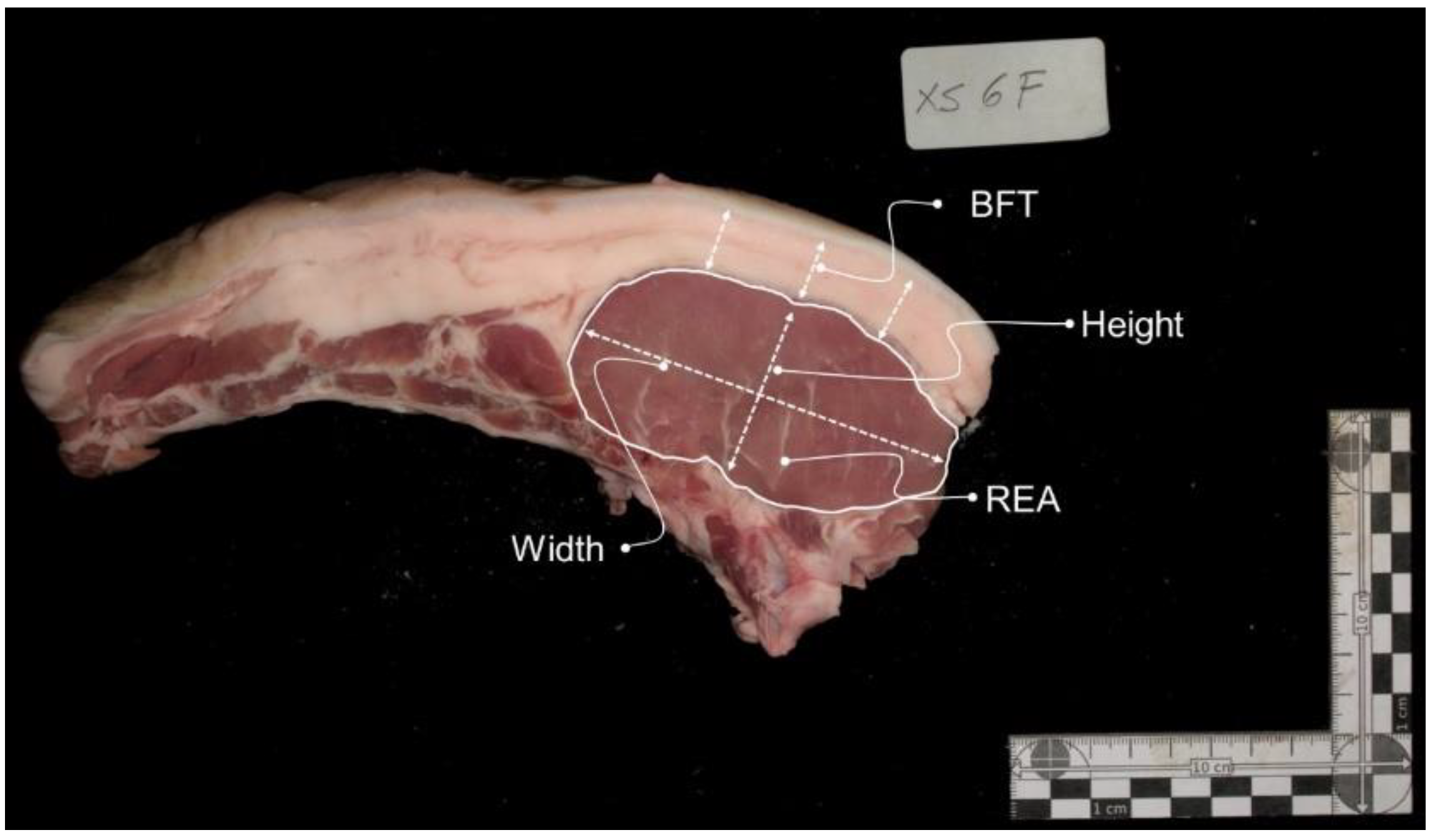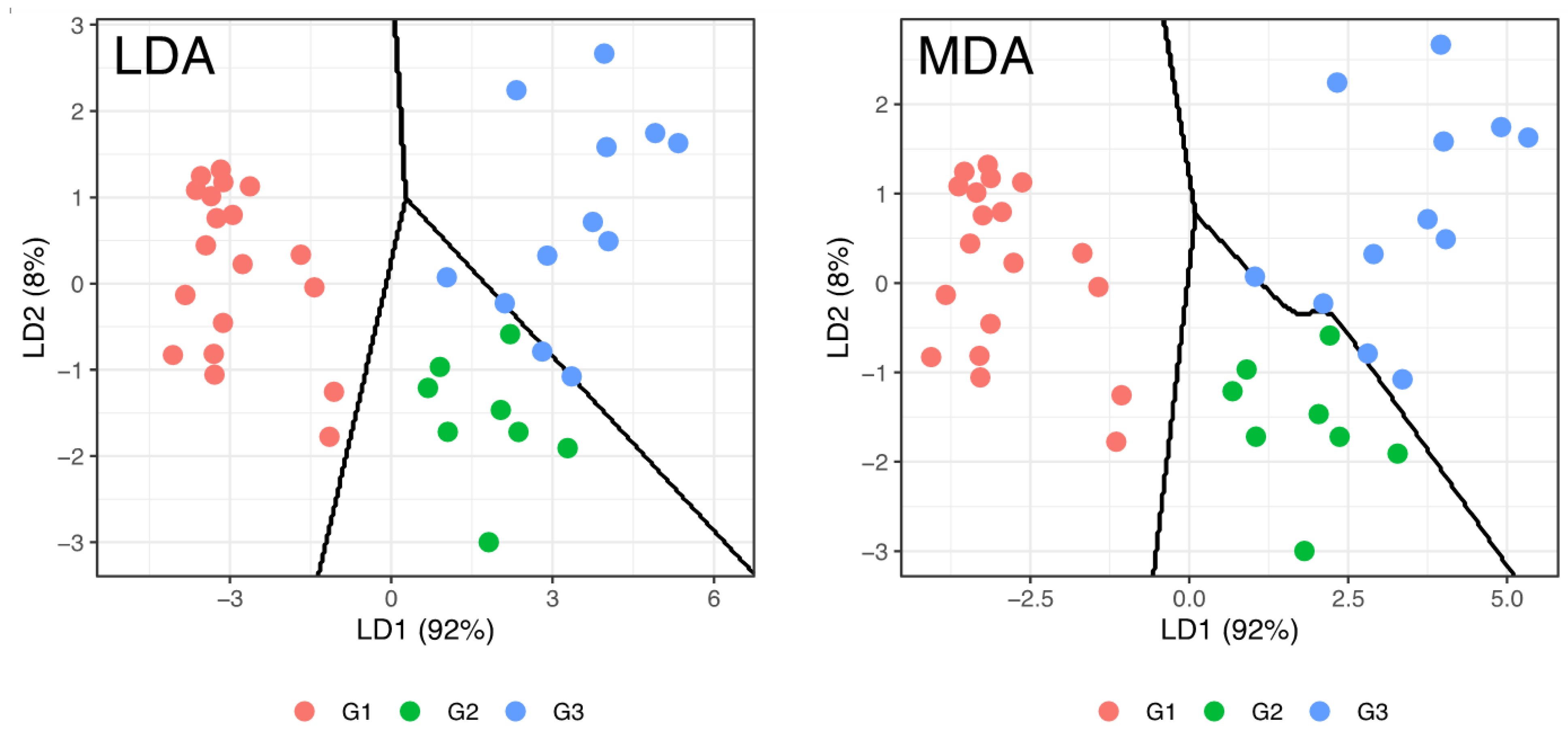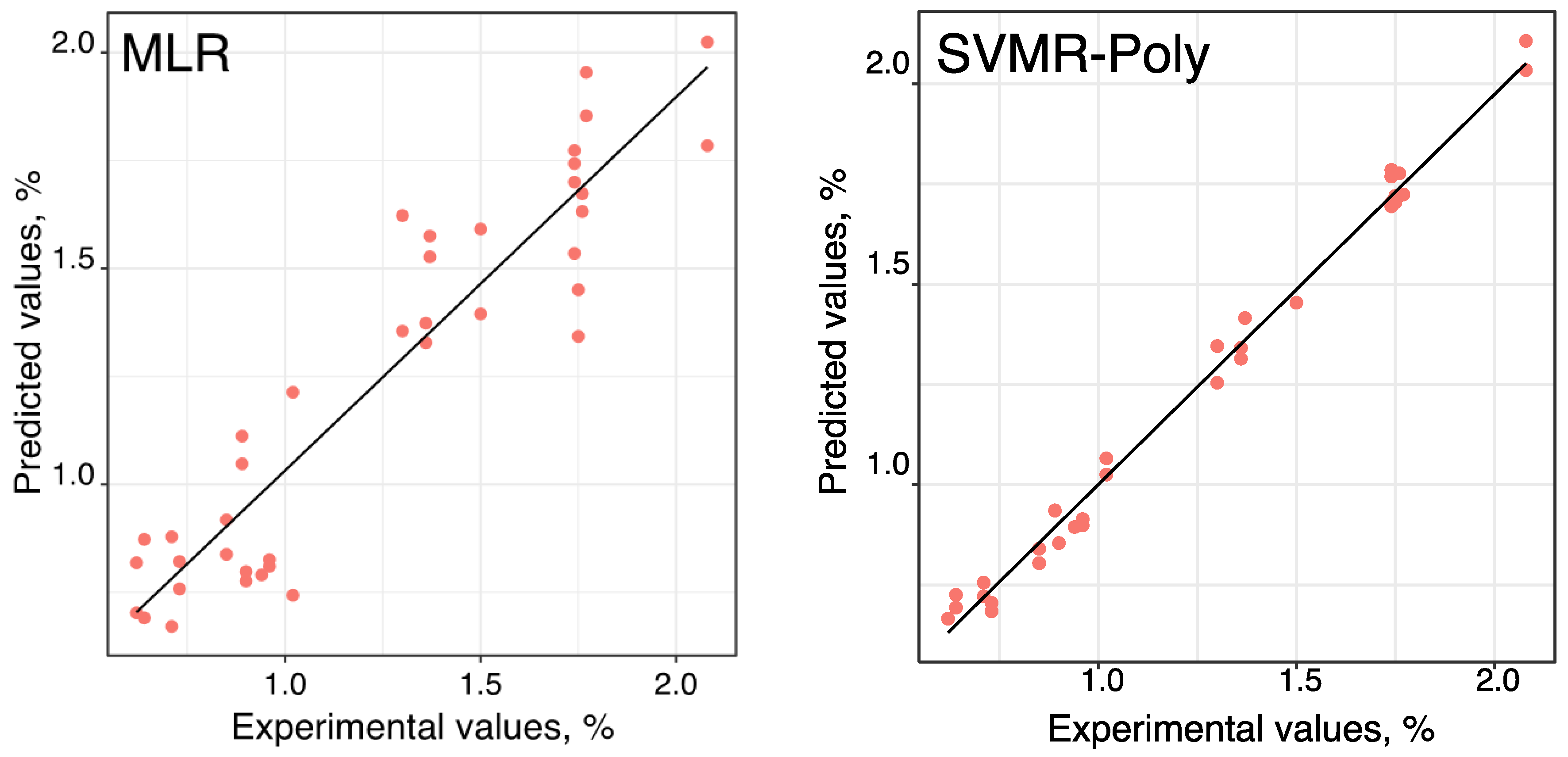Intramuscular Fat Prediction Using Color and Image Analysis of Bísaro Pork Breed
Abstract
:1. Introduction
2. Material and Methods
2.1. Animals and Sampling
2.2. Color Measurement
2.3. Chemical Analysis
2.4. Image Acquisition
2.5. Muscle and Subcutaneous Fat Measurements
2.6. Marbling Fleck Features Extraction
2.7. Statistical Analysis
3. Results and Discussion
3.1. Data Matrix
3.2. Semi-Quantitative Analysis
3.3. Quantitative Analysis
4. Conclusions
Author Contributions
Funding
Institutional Review Board Statement
Informed Consent Statement
Acknowledgments
Conflicts of Interest
References
- Olsen, E.V.; Christensen, L.B.; Nielsen, D.B. A review of computed tomography and manual dissection for calibration of devices for pig carcass classification-Evaluation of uncertainty. Meat Sci. 2017, 123, 35–44. [Google Scholar] [CrossRef]
- Kucha, C.T.; Liu, L.; Ngadi, M.O. Non-destructive spectroscopic techniques and multivariate analysis for assessment of fat quality in pork and pork products: A review. Sensors 2018, 18, 377. [Google Scholar] [CrossRef] [Green Version]
- Font-i-Furnols, M.; Tous, N.; Esteve-Garcia, E.; Gispert, M. Do all the consumers accept marbling in the same way? The relationship between eating and visual acceptability of pork with different intramuscular fat content. Meat Sci. 2012, 91, 448–453. [Google Scholar] [CrossRef] [PubMed]
- Argemí-Armengol, I.; Villalba, D.; Ripoll, G.; Teixeira, A.; Álvarez-Rodríguez, J. Credence cues of pork are more important than consumers’ culinary skills to boost their purchasing intention. Meat Sci. 2019, 154, 11–21. [Google Scholar] [CrossRef] [PubMed] [Green Version]
- Silva, S.R.; Teixeira, A.; Font-i-Furnols, M. Intramuscular fat and marbling. In Handbook of Reference Methods for the Assessment of Meat Quality Parameters; Font-i-Furnols, M., Čandek-Potokar, M., Maltin, C., Prevolnik Povše, M., Eds.; SRUC: Edinburgh, UK, 2015; pp. 12–21. [Google Scholar]
- Álvarez-Rodríguez, J.; Teixeira, A. Slaughter weight rather than sex affects carcass cuts and tissue composition of Bisaro pigs. Meat Sci. 2019, 154, 54–60. [Google Scholar] [CrossRef] [PubMed]
- Scholz, A.M.; Bünger, L.; Kongsro, J.; Baulain, U.; Mitchell, A.D. Non-invasive methods for the determination of body and carcass composition in livestock: Dual energy X-ray absorptiometry, computed tomography, magnetic resonance imaging and ultrasound: Invited review. Animal 2015, 9, 1250–1264. [Google Scholar] [CrossRef] [Green Version]
- Barlocco, N.; Vadell, A.; Ballesteros, F.; Galietta, G.; Cozzolino, D. Predicting intramuscular fat, moisture and Warner-Bratzler shear force in pork muscle using near infrared reflectance spectroscopy. Anim. Sci. 2006, 82, 111–116. [Google Scholar] [CrossRef]
- Huang, H.; Liu, L.; Ngadi, M.O. Quantitative evaluation of pork marbling score along Longissimus thoracis using NIR images of rib end. Biosyst. Eng. 2017, 164, 147–156. [Google Scholar] [CrossRef]
- Ville, H.; Rombouts, G.; Van Hecke, P.; Perremans, S. An evaluation of ultrasound and nuclear magnetic resonance spectroscopy to measure in vivo intramuscular fat content of longissimus muscle of pigs. J. Anim. Sci. 1997, 75, 2942–2949. [Google Scholar] [CrossRef] [Green Version]
- Font-i-Furnols, M.; Brun, A.; Tous, N.; Gispert, M. Use of linear regression and partial least square regression to predict intramuscular fat of pig loin computed tomography images. Chemometr. Intell. Lab. Syst. 2013, 122, 58–64. [Google Scholar] [CrossRef]
- Font-i-Furnols, M.; Brun, A.; Gispert, M. Intramuscular fat content in different muscles, locations, weights and genotype-sexes and its prediction in live pigs with computed tomography. Animal 2019, 13, 666–674. [Google Scholar] [CrossRef] [PubMed]
- Huang, H.; Liu, L.; Ngadi, M.O.; Gariépy, C. Prediction of pork marbling scores using pattern analysis techniques. Food Control 2013, 31, 224–229. [Google Scholar] [CrossRef]
- Huang, H.; Liu, L.; Ngadi, M.O. Assessment of intramuscular fat content of pork using NIR hyperspectral images of rib end. J. Food Eng. 2017, 193, 29–41. [Google Scholar] [CrossRef]
- Faucitano, L.; Huff, P.; Teuscher, F.; Gariepy, C.; Wegner, J. Application of computer image analysis to measure pork marbling characteristics. Meat Sci. 2005, 69, 537–543. [Google Scholar] [CrossRef]
- Liu, J.H.; Sun, X.; Young, J.M.; Bachmeier, L.A.; Newman, D.J. Predicting pork loin intramuscular fat using computer vision system. Meat Sci. 2018, 143, 18–23. [Google Scholar] [CrossRef]
- Official Journal of the European Union. Official Journal of the European Union Council Regulation (EC) No 510/2006 ‘Carne de Bísaro Transmontano’ or ‘Carne de Porco Transmontano’ No: EC PT/PDO/005/0457/20.04.2005 C89 24.04.2007; Official Journal of the European Union: Luxembourg, 2007; pp. 23–25. [Google Scholar]
- Directive, Council Regulation No1099/2009 on the protection of animals at the time of killing. Off. J. Eur. Union 2009, 303, 1–30.
- CIE. Commission Internationale de l’Eclairage (CIE). Colorimetry, 2nd ed.; Publication CIE No. 15.2; Commission Internationale de l’Eclairage: Vienna, Austria, 1986. [Google Scholar]
- AOAC. Oils and fats. In AOAC International Official Methods of Analysis, 17th ed.; Association of Official Analytical Chemists: Gaithersburg, MD, USA, 2000. [Google Scholar]
- Hanlon, K.L. Cross-polarised and parallel-polarised light: Viewing and photography for examination and documentation of biological materials in medicine and forensics. J. Vis. Commun. Med. 2018, 41, 3–8. [Google Scholar] [CrossRef]
- He, W.-H.; Park, C.J.; Byun, S.; Tan, D.; Lin, C.Y.; Chee, W. Evaluating the relationship between tooth color and enamel thickness, using twin flash photography, cross-polarization photography, and spectrophotometer. J. Esthet. Restor. Dent. 2020, 32, 91–101. [Google Scholar] [CrossRef]
- Villavicencio-Espinoza, C.A.; Narimatsu, M.H.; Furuse, A.Y. Using cross-polarized photography as a guide for selecting resin composite shade. Oper. Dent. 2018, 43, 113–120. [Google Scholar] [CrossRef]
- Rasband, W.S.; ImageJ, U.S. National Institutes of Health, Bethesda, Maryland, USA. 2018. Available online: https://imagej.nih.gov/ij/ (accessed on 1 January 2019).
- Friedman, J.; Hastie, T.; Tibshirani, R. The Elements of Statistical Learning, Data Mining, Inference and Prediction; Springer: Berlin/Heidelberg, Germany, 2008. [Google Scholar]
- Kuhn, M.; Johnson, K. Applied Predictive Modeling; Springer: New York, NY, USA, 2013. [Google Scholar]
- Liang, Y.; Xu, Q.-S.; Li, H.-D.; Cao, D.-S. Support Vector Machines and Their Application in Chemistry and Biotechnology; CRC Press, Taylor & Francis Group: Boca Raton, FL, USA, 2011. [Google Scholar]
- Kuhn, M. Caret: Classification and Regression Training, R package version 6.0-86; R Team: Vienna, Austria, 2020. [Google Scholar]
- Meyer, D.; Dimitriadou, E.; Hornik, K.; Weingessel, A.; Leisch, F. e1071: Misc Functions of the Department of Statistics, Probability Theory Group (Formerly: E1071), TU Wien, R package version 1.7-3; R Team: Vienna, Austria, 2019. [Google Scholar]
- Auguie, B. gridExtra: Miscellaneous Functions for “Grid” Graphics, R package version 2.3; R Team: Vienna, Austria, 2017. [Google Scholar]
- Wickham, H. ggplot2: Elegant Graphics for Data Analysis; Springer: New York, NY, USA, 2016. [Google Scholar]
- Wickham, H.; Seidel, D. Scales: Scale Functions for Visualization, R package version; R Team: Vienna, Austria, 2020. [Google Scholar]
- Venables, W.N.; Ripley, B.D. Modern Applied Statistics with S, 4th ed.; Springer: New York, NY, USA, 2002. [Google Scholar]
- Hastie, T.; Tibshirani, R. Original R Port by Leisch, F., Hornik, K., Ripley, B.D., Narasimhan, B. Has Contributed to the Upgrading of the Code, MDA: Mixture and Flexible Discriminant Analysis, R package version 0.5; R Team: Vienna, Austria, 2010. [Google Scholar]
- Revelle, W. psych: Procedures for Personality and Psychological Research, R package version 1.9.12; Northwestern University: Evanston, IL, USA, 2019. [Google Scholar]
- Tyra, M.; Zak, G. Characteristics of the polish breeding population of pigs in terms of intramuscular fat (IMF) content of m. longissimus dorsi. Ann. Anim. Sci. 2010, 10, 241–248. [Google Scholar]
- Ludwiczak, A.; Stanisz, M.; Lisiak, D.; Janiszewski, P.; Bykowska, M.; Składanowska, J.; Ślósarz, P. Novel ultrasound approach for measuring marbling in pork. Meat Sci. 2017, 131, 176–182. [Google Scholar] [CrossRef] [PubMed]
- Lebret, B.; Ecolan, P.; Bonhomme, N.; Méteau, K.; Prunier, A. Influence of production system in local and conventional pig breeds on stress indicators at slaughter, muscle and meat traits and pork eating quality. Animal 2015, 9, 1404–1413. [Google Scholar] [CrossRef] [PubMed] [Green Version]
- Liu, L.; Ngadi, M. Predicting intramuscular fat content of pork using hyperspectral imaging. J. Food Eng. 2014, 134, 16–23. [Google Scholar] [CrossRef]
- Andersen, P.V.; Wold, J.P.; Gjerlaug-Enger, E.; Veiseth-Kent, E. Predicting post-mortem meat quality in porcine longissimus lumborum using Raman, near infrared and fluorescence spectroscopy. Meat Sci. 2018, 145, 94–100. [Google Scholar] [CrossRef] [PubMed]
- Taheri-Garavand, A.; Fatahi, S.; Omid, M.; Makino, Y. Meat quality evaluation based on computer vision technique: A review. Meat Sci. 2019, 156, 183–195. [Google Scholar] [CrossRef] [PubMed]
- Daniel, H.; González, G.V.; García, M.V.; Rivero, A.J.L.; De Paz, J.F. Non-invasive automatic beef carcass classification based on sensor network and image analysis. Future Gener. Comput. Syst. 2020, 113, 318–328. [Google Scholar] [CrossRef]
- Meunier, B.; Normand, J.; Albouy-Kissi, B.; Micol, D.; El Jabri, M.; Bonnet, M. An open-access computer image analysis (CIA) method to predict meat and fat content from an android smartphone-derived picture of the bovine 5th-6th rib. Methods 2020. [Google Scholar] [CrossRef] [PubMed]




| Parameters | Minimum | Maximum | Median | CV (%) |
|---|---|---|---|---|
| Dependent variable | ||||
| IMF% | 0.62 | 2.08 | 1.30 | 36.0 |
| Independent variables | ||||
| Animal body variable | ||||
| CW (kg) | 14.9 | 89.3 | 25.5 | 67.3 |
| CIELAB color variables | ||||
| L* | 44.8 | 61.9 | 55.1 | 7.0 |
| a* | 0.99 | 13.6 | 3.40 | 71.1 |
| b* | 6.84 | 14.6 | 10.9 | 18.5 |
| C* | 9.00 | 17.0 | 12.7 | 17.1 |
| H* | 34.1 | 83.8 | 73.4 | 23.2 |
| IA variables | ||||
| Width (cm) | 5.3 | 12.0 | 8.16 | 18.6 |
| Height (cm) | 2.74 | 8.75 | 4.45 | 28.0 |
| REA (cm2) | 11.7 | 55.0 | 23.7 | 40.4 |
| BFT (cm) | 0.39 | 6.05 | 1.30 | 65.1 |
| NOParticles | 16 | 59 | 27 | 34.5 |
| Marb_area (mm2) | 0.14 | 2.03 | 0.38 | 71.1 |
| Marb_area% | 1.03 | 3.92 | 1.75 | 36.1 |
| Parameter | LDA | MDA |
|---|---|---|
| Average cross-validation results | ||
| Accuracy | 0.68 ± 0.17 | 0.92 ± 0.12 |
| Best model prediction capability | ||
| Accuracy | 0.95 ± 0.03 | 1.00 |
| CIAccuracy | [0.83, 0.99] | [0.91, 1.00] |
| p-value | <0.001 | <0.001 |
| G1 balanced accuracy | 1.00 | 1.00 |
| G2 balanced accuracy | 0.97 | 1.00 |
| G3 balanced accuracy | 0.92 | 1.00 |
| Parameter | MLR | SVMR-Poly |
|---|---|---|
| Average cross-validation results | ||
| Rcv2 | 0.76 ± 0.13 | 0.88 ± 0.12 |
| RMSE | 0.26 ± 0.08 | 0.18 ± 0.11 |
| Best model prediction capability | ||
| Rc2Adjusted | 0.86 | 0.999 |
| RSE | 0.16 | 0.04 |
| p-value | <0.001 | <0.001 |
| Slope | 0.86 ± 0.06 | 0.993 ± 0.005 |
| CISlope | [0.75, 0.98] | [0.982, 1.000] |
| Intercept | 0.17 ± 0.07 | ns |
| CIIntercept | [0.02, 0.32] | na |
Publisher’s Note: MDPI stays neutral with regard to jurisdictional claims in published maps and institutional affiliations. |
© 2021 by the authors. Licensee MDPI, Basel, Switzerland. This article is an open access article distributed under the terms and conditions of the Creative Commons Attribution (CC BY) license (http://creativecommons.org/licenses/by/4.0/).
Share and Cite
Teixeira, A.; Silva, S.R.; Hasse, M.; Almeida, J.M.H.; Dias, L. Intramuscular Fat Prediction Using Color and Image Analysis of Bísaro Pork Breed. Foods 2021, 10, 143. https://doi.org/10.3390/foods10010143
Teixeira A, Silva SR, Hasse M, Almeida JMH, Dias L. Intramuscular Fat Prediction Using Color and Image Analysis of Bísaro Pork Breed. Foods. 2021; 10(1):143. https://doi.org/10.3390/foods10010143
Chicago/Turabian StyleTeixeira, Alfredo, Severiano R. Silva, Marianne Hasse, José M. H. Almeida, and Luis Dias. 2021. "Intramuscular Fat Prediction Using Color and Image Analysis of Bísaro Pork Breed" Foods 10, no. 1: 143. https://doi.org/10.3390/foods10010143







